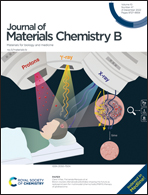Supramolecular catalytic nanomedicines based on coordination self-assembly of amino acids for cascade-activated and -amplified synergetic cancer therapy†
Abstract
Simple biomolecule-based supramolecular nanomedicines hold great promise in cancer therapy, but their clinical translation is greatly hindered by low tumor-specificity and unsatisfactory antitumor performance. Herein, we developed an amino acid basedsupramolecular nanomedicine that could be co-activated by multiple stimuli in tumor tissue to trigger cascade catalytic reactions in situ for synergetic therapy. The supramolecular nanomedicine was developed based on a combination of coordination and hydrophobic noncovalent interactions among amphiphilic amino acids, glucose oxidase (GOx), copper ions, as well as doxorubicin (DOX)–camptothecin (CPT) prodrugs. The cascade reactions including the catalytic oxidation of glucose to generate H2O2, GSH reducing Cu2+ to Cu+, a Fenton-like reaction between H2O2 and Cu+ to produce hydroxyl radicals (˙OH), and ˙OH-triggered rapid release of dual parent drugs were specifically activated in tumor cells. With these cascade reactions, the catalytic-chemo synergetic therapy was realized for high-efficiency tumor suppression.



 Please wait while we load your content...
Please wait while we load your content...